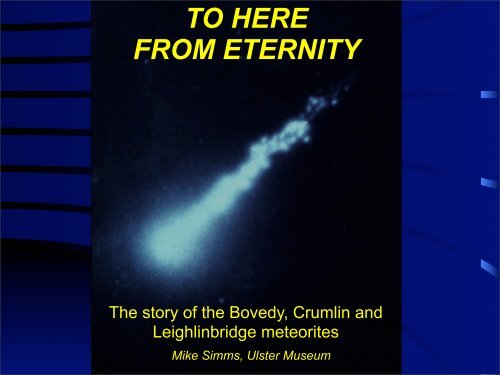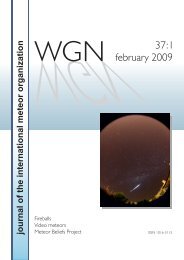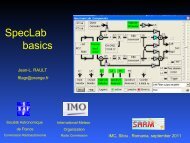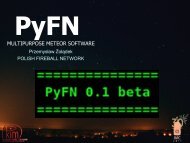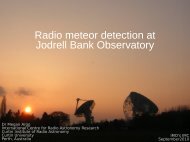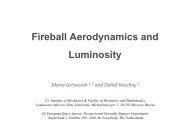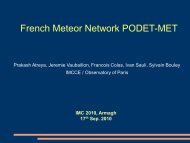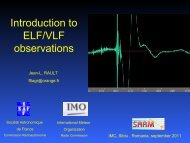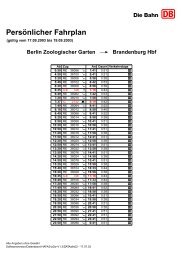Mike Simms (invited): To Here From Eternity
Mike Simms (invited): To Here From Eternity
Mike Simms (invited): To Here From Eternity
Create successful ePaper yourself
Turn your PDF publications into a flip-book with our unique Google optimized e-Paper software.
TO HERE<br />
FROM ETERNITY<br />
The story of the Bovedy, Crumlin and<br />
Leighlinbridge meteorites<br />
<strong>Mike</strong> <strong>Simms</strong>, Ulster Museum
Friday 25th April 1969<br />
9.25 p.m.<br />
A fireball streaks<br />
across the night sky
Friday 25th April 1969<br />
9.25 p.m.<br />
A fireball streaks<br />
across the night sky
It takes less than a minute to cross the UK!
…and barely 15 seconds to<br />
cross Northern Ireland
A small rock smashes<br />
a roof near Lisburn
A bigger one lands in a field<br />
near Garvagh.<br />
These are meteorites - the first<br />
found in Ireland since 1902, and<br />
the last for another 30 years.
Where else have they<br />
fallen in Ireland?<br />
Only 8 meteorite falls<br />
in 230 years!
The Bovedy, Crumlin and<br />
Leighlinbridge meteorites<br />
all fell in the 20th Century<br />
Crumlin meteorite<br />
L5 Ordinary Chondrite<br />
Bovedy meteorite<br />
L3 Ordinary Chondrite<br />
all are<br />
Type L Ordinary Chondrites<br />
(these are slices)<br />
Leighlinbridge meteorite<br />
L6 Ordinary Chondrite
Types of meteorites and their abundance (%)<br />
Stony Meteorites Falls Finds<br />
Ordinary Chondrites 76.9% 50.9%<br />
Carbonaceous Chondrites 3.7%<br />
Other chondrite types 1.7%<br />
Achondrites 7.7%<br />
Ungrouped 4.3%<br />
Irons 4.2% 20.8%<br />
Stony-irons 1.3%<br />
…which is why they are called Ordinary Chondrites.
Types of Ordinary Chondrite<br />
(each comes from its own parent planet)<br />
Type H (High in iron)<br />
Mooresfort 1810<br />
Limerick 1813<br />
Killeter 1844<br />
Dundrum 1865<br />
Crumlin 1902<br />
Bovedy 1969<br />
Leighlinbridge 1999<br />
Type L (Low in iron)
In the beginning, >4568 million years ago…
Star formation triggered by a supernova<br />
Al 26<br />
Fe 60
The Sun forms.<br />
Planets accrete and melt.
Planetismal<br />
accretion<br />
Melting<br />
(due to Al 26 and Fe 60 )<br />
Differentiation
Pallasite meteorites<br />
(planet mantle)<br />
Iron meteorites<br />
(planet core)<br />
Achondrite<br />
meteorites<br />
(planet crust)
Pallasite meteorites<br />
(planet mantle)<br />
But none of these are<br />
chondrite meteorites…<br />
Iron meteorites<br />
(planet core)<br />
Achondrite<br />
meteorites<br />
(planet crust)
Sprucefield slice<br />
How and when did the chondrules form?
Splashes from the collision of molten planetismals.<br />
“Drops of fiery rain.” (H.C.Sorby, 1877)
How old are the L Chondrite meteorites? Radiogenic dating
Followed by slow cooking of<br />
the L Chondrite planet for<br />
tens of millions of years<br />
Bovedy<br />
Crumlin<br />
L3 850 o C<br />
Leighlinbridge<br />
D ~ 200 km
For the next four billion years,<br />
nothing much happened…
For the next four billion years,<br />
nothing much happened…<br />
And then…
…something shocking…
…which knocked the<br />
wind argon out of it…<br />
Argon dating<br />
About the<br />
age it ought<br />
to be
Most L chondrites lie<br />
about their age
Catastrophic destruction of the L Chondrite parent planet
Many fossil meteorites have been found in 470 million year<br />
old rocks. All are L Chondrites.<br />
467.3 + 1.6 Ma ago<br />
467.3 + 1.6 Ma ago
How do they get<br />
to Earth?<br />
Mr. Kirkwood’s<br />
Cosmic Catapult
…more like a<br />
swing actually
Asteroid Belt<br />
Jupiter<br />
Sun<br />
What happens to anything that strays into the 3:1 Kirkwood Gap?
For every one orbit of Jupiter, our rock makes 3 orbits.
Lap 1
Wobble!
Lap 2
Wobble!<br />
Lap 3
Travel time?
Travel time?<br />
A few hundred thousand years
Meteorite travel times: Cosmic Ray Exposure ages
~467 Ma ago<br />
all reached Earth in
~467 Ma ago<br />
all reached Earth in 10 Ma to reach Earth<br />
Why have the rest taken so long?
Yarkovsky Drift to<br />
reach a Kirkwood Gap
Where is the L Chondrite parent body?<br />
Are there many to choose from?
Where is the L Chondrite parent body?<br />
Must be near a Kirkwood Resonance that delivers to Earth
Is it Flora?<br />
Close to the 7:2 and nu6 resonances<br />
nu6<br />
7:2
Meteorite<br />
compositions<br />
Asteroid<br />
compositions<br />
apparently not…
nu6<br />
7:2 3:1 8:3 5:2 7:3<br />
2:1<br />
Perhaps Gefion?<br />
Close to the 5:2 resonance
Where can I go to<br />
see meteorites?
See Bovedy and other meteorites at Armagh Planetarium
New meteorite display at<br />
the Ulster Museum<br />
Seymchan<br />
Millbillillie<br />
Bovedy


